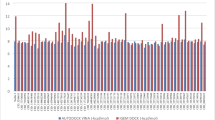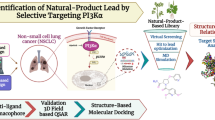Abstract
The inhibition of tumor suppressor p53 protein due to its direct interaction with oncogenic murine double minute 2 (MDM2) protein, plays a central role in almost 50 % of all human tumor cells. Therefore, pharmacological inhibition of the p53-binding pocket on MDM2, leading to p53 activation, presents an important therapeutic target against these cancers expressing wild-type p53. In this context, the present study utilized an integrated virtual and experimental screening approach to screen a database of approved drugs for potential p53-MDM2 interaction inhibitors. Specifically, using an ensemble rigid-receptor docking approach with four MDM2 protein crystal structures, six drug molecules were identified as possible p53-MDM2 inhibitors. These drug molecules were then subjected to further molecular modeling investigation through flexible-receptor docking followed by Prime/MM-GBSA binding energy analysis. These studies identified fluspirilene, an approved antipsychotic drug, as a top hit with MDM2 binding mode and energy similar to that of a native MDM2 crystal ligand. The molecular dynamics simulations suggested stable binding of fluspirilene to the p53-binding pocket on MDM2 protein. The experimental testing of fluspirilene showed significant growth inhibition of human colon tumor cells in a p53-dependent manner. Fluspirilene also inhibited growth of several other human tumor cell lines in the NCI60 cell line panel. Taken together, these computational and experimental data suggest a potentially novel role of fluspirilene in inhibiting the p53-MDM2 interaction. It is noteworthy here that fluspirilene has a long history of safe human use, thus presenting immediate clinical potential as a cancer therapeutic. Furthermore, fluspirilene could also serve as a structurally-novel lead molecule for the development of more potent, small-molecule p53-MDM2 inhibitors against several types of cancer. Importantly, the combined computational and experimental screening protocol presented in this study may also prove useful for screening other commercially-available compound databases for identification of novel, small molecule p53-MDM2 inhibitors.




Similar content being viewed by others
References
Harris SL, Levine AJ (2005) The p53 pathway: positive and negative feedback loops. Oncogene 24(17):2899–2908
Toledo F, Wahl GM (2006) Regulating the p53 pathway: in vitro hypotheses, in vivo veritas. Nat Rev Cancer 6(12):909–923
Moll UM, Petrenko O (2003) The MDM2-p53 interaction. Mol Cancer Res MCR 1(14):1001–1008
Kussie PH, Gorina S, Marechal V, Elenbaas B, Moreau J, Levine AJ, Pavletich NP (1996) Structure of the MDM2 oncoprotein bound to the p53 tumor suppressor transactivation domain. Science 274(5289):948–953
Chene P (2003) Inhibiting the p53-MDM2 interaction: an important target for cancer therapy. Nat Rev Cancer 3(2):102–109
Vassilev LT, Vu BT, Graves B, Carvajal D, Podlaski F, Filipovic Z, Kong N, Kammlott U, Lukacs C, Klein C, Fotouhi N, Liu EA (2004) In vivo activation of the p53 pathway by small-molecule antagonists of MDM2. Science 303(5659):844–848
Zhan C, Lu W (2011) Peptide activators of the p53 tumor suppressor. Curr Pharm Des 17(6):603–609
Wells JA, McClendon CL (2007) Reaching for high-hanging fruit in drug discovery at protein–protein interfaces. Nature 450(7172):1001–1009
Grasberger BL, Lu T, Schubert C, Parks DJ, Carver TE, Koblish HK, Cummings MD, LaFrance LV, Milkiewicz KL, Calvo RR, Maguire D, Lattanze J, Franks CF, Zhao S, Ramachandren K, Bylebyl GR, Zhang M, Manthey CL, Petrella EC, Pantoliano MW, Deckman IC, Spurlino JC, Maroney AC, Tomczuk BE, Molloy CJ, Bone RF (2005) Discovery and cocrystal structure of benzodiazepinedione HDM2 antagonists that activate p53 in cells. J Med Chem 48(4):909–912
Shangary S, Qin D, McEachern D, Liu M, Miller RS, Qiu S, Nikolovska-Coleska Z, Ding K, Wang G, Chen J, Bernard D, Zhang J, Lu Y, Gu Q, Shah RB, Pienta KJ, Ling X, Kang S, Guo M, Sun Y, Yang D, Wang S (2008) Temporal activation of p53 by a specific MDM2 inhibitor is selectively toxic to tumors and leads to complete tumor growth inhibition. Proc Natl Acad Sci USA 105(10):3933–3938
Warner WA, Sanchez R, Dawoodian A, Li E, Momand J (2012) Identification of FDA-approved drugs that computationally bind to MDM2. Chem Biol Drug Des 80(4):631–637
Irwin JJ, Shoichet BK (2005) ZINC–a free database of commercially available compounds for virtual screening. J Chem Inf Model 45(1):177–182
Berman HM, Westbrook J, Feng Z, Gilliland G, Bhat TN, Weissig H, Shindyalov IN, Bourne PE (2000) The protein data bank. Nucleic Acids Res 28(1):235–242
Sanner MF (1999) Python: a programming language for software integration and development. J Mol Graph Model 17(1):57–61
Morris GM, Huey R, Lindstrom W, Sanner MF, Belew RK, Goodsell DS, Olson AJ (2009) AutoDock4 and AutoDockTools4: automated docking with selective receptor flexibility. J Comput Chem 30(16):2785–2791
Trott O, Olson AJ (2010) AutoDock Vina: improving the speed and accuracy of docking with a new scoring function, efficient optimization, and multithreading. J Comput Chem 31(2):455–461
Popowicz GM, Czarna A, Wolf S, Wang K, Wang W, Domling A, Holak TA (2010) Structures of low molecular weight inhibitors bound to MDMX and MDM2 reveal new approaches for p53-MDMX/MDM2 antagonist drug discovery. Cell Cycle 9(6):1104–1111
Wang F, Li Y, Ma Z, Wang X, Wang Y (2012) Structural determinants of benzodiazepinedione/peptide-based p53-HDM2 inhibitors using 3D-QSAR, docking and molecular dynamics. J Mol Model 18(1):295–306
Lyne PD, Lamb ML, Saeh JC (2006) Accurate prediction of the relative potencies of members of a series of kinase inhibitors using molecular docking and MM-GBSA scoring. J Med Chem 49(16):4805–4808
Popowicz GM, Domling A, Holak TA (2011) The structure-based design of Mdm2/Mdmx-p53 inhibitors gets serious. Angew Chem 50(12):2680–2688
Sherman W, Day T, Jacobson MP, Friesner RA, Farid R (2006) Novel procedure for modeling ligand/receptor induced fit effects. J Med Chem 49(2):534–553
Patil SP, Ballester PJ, Kerezsi CR (2014) Prospective virtual screening for novel p53-MDM2 inhibitors using ultrafast shape recognition. J Comput Aided Mol Des 28(2):89–97
Janssen PA, Niemegeers CJ, Schellekens KH, Lenaerts FM, Verbruggen FJ, van Nueten JM, Marsboom RH, Herin VV, Schaper WK (1970) The pharmacology of fluspirilene (R 6218), a potent, long-acting and injectable neuroleptic drug. Arzneimittelforschung 20(11):1689–1698
Uhrinova S, Uhrin D, Powers H, Watt K, Zheleva D, Fischer P, McInnes C, Barlow PN (2005) Structure of free MDM2 N-terminal domain reveals conformational adjustments that accompany p53-binding. J Mol Biol 350(3):587–598
Bista M, Wolf S, Khoury K, Kowalska K, Huang Y, Wrona E, Arciniega M, Popowicz GM, Holak TA, Domling A (2013) Transient protein states in designing inhibitors of the MDM2-p53 interaction. Structure 21(12):2143–2151
Moghaddas Gholami A, Hahne H, Wu Z, Auer FJ, Meng C, Wilhelm M, Kuster B (2013) Global proteome analysis of the NCI-60 cell line panel. Cell Rep 4(3):609–620
Wiklund ED, Catts VS, Catts SV, Ng TF, Whitaker NJ, Brown AJ, Lutze-Mann LH (2010) Cytotoxic effects of antipsychotic drugs implicate cholesterol homeostasis as a novel chemotherapeutic target. Int J Cancer J Int Cancer 126(1):28–40
Hassel P (1985) Experimental comparison of low doses of 1.5 mg fluspirilene and bromazepam in out-patients with psychovegetative disturbances. Pharmacopsychiatry 18(5):297–302
Seeman P (1980) Brain dopamine receptors. Pharmacol Rev 32(3):229–313
Soni SD (1977) Fluspirilene in the treatment of non-hospitalized schizophrenic patients. Curr Med Res Opin 4(9):645–649
The docking search space coordinates used for Autock Vina screening were: 4HG7 [Center X:-19.750, Y:13.9838, Z:-8.2689; Dimensions (Å) X:34.1653, Y:39.7419, Z:29.5033], 1RV1 [Center X:13.5799, Y:0.8461, Z:19.5511; Dimensions (Å) X:44.1592, Y:34.3006, Z:28.3009], 3LBL [Center X:-28.9098, Y:17.4573, Z:-50.1283; Dimensions (Å) X:38.5244, Y:32.8518, Z:32.6208], and 3LBK [Center X:18.8133, Y:10.8160, Z:4.4580; Dimensions (Å) X:33.6391, Y:34.8912, Z:33.4187]
Acknowledgments
We thank Dr. Bert Vogelstein at the Johns Hopkins University for the HCT-116 cell lines and Dr. Jeffrey Rufinus from Department of Computer Science for use of computer cluster for molecular dynamics simulations. We also thank the National Cancer Institute (NCI) for carrying out NCI60 screening of fluspirilene. The present study is supported by the Widener University Provost Grant to Dr. Sachin P. Patil.
Author information
Authors and Affiliations
Corresponding author
Electronic supplementary material
Below is the link to the electronic supplementary material.
Rights and permissions
About this article
Cite this article
Patil, S.P., Pacitti, M.F., Gilroy, K.S. et al. Identification of antipsychotic drug fluspirilene as a potential p53-MDM2 inhibitor: a combined computational and experimental study. J Comput Aided Mol Des 29, 155–163 (2015). https://doi.org/10.1007/s10822-014-9811-6
Received:
Accepted:
Published:
Issue Date:
DOI: https://doi.org/10.1007/s10822-014-9811-6




